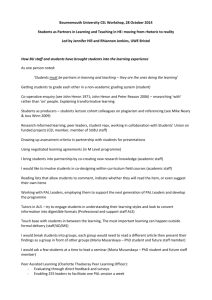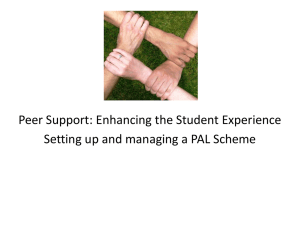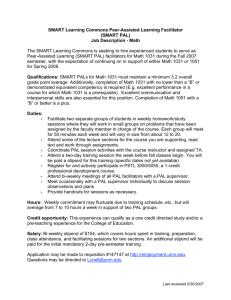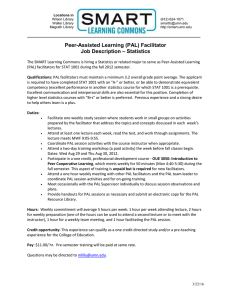Document 10466749
advertisement
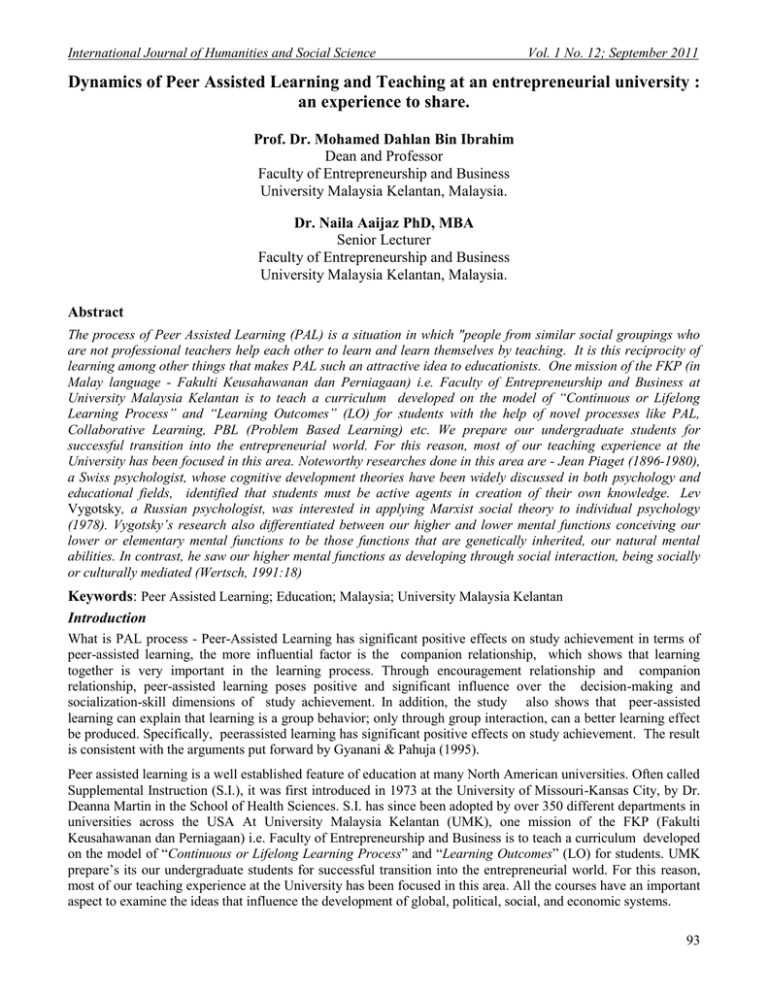
International Journal of Humanities and Social Science Vol. 1 No. 12; September 2011 Dynamics of Peer Assisted Learning and Teaching at an entrepreneurial university : an experience to share. Prof. Dr. Mohamed Dahlan Bin Ibrahim Dean and Professor Faculty of Entrepreneurship and Business University Malaysia Kelantan, Malaysia. Dr. Naila Aaijaz PhD, MBA Senior Lecturer Faculty of Entrepreneurship and Business University Malaysia Kelantan, Malaysia. Abstract The process of Peer Assisted Learning (PAL) is a situation in which "people from similar social groupings who are not professional teachers help each other to learn and learn themselves by teaching. It is this reciprocity of learning among other things that makes PAL such an attractive idea to educationists. One mission of the FKP (in Malay language - Fakulti Keusahawanan dan Perniagaan) i.e. Faculty of Entrepreneurship and Business at University Malaysia Kelantan is to teach a curriculum developed on the model of “Continuous or Lifelong Learning Process” and “Learning Outcomes” (LO) for students with the help of novel processes like PAL, Collaborative Learning, PBL (Problem Based Learning) etc. We prepare our undergraduate students for successful transition into the entrepreneurial world. For this reason, most of our teaching experience at the University has been focused in this area. Noteworthy researches done in this area are - Jean Piaget (1896-1980), a Swiss psychologist, whose cognitive development theories have been widely discussed in both psychology and educational fields, identified that students must be active agents in creation of their own knowledge. Lev Vygotsky, a Russian psychologist, was interested in applying Marxist social theory to individual psychology (1978). Vygotsky’s research also differentiated between our higher and lower mental functions conceiving our lower or elementary mental functions to be those functions that are genetically inherited, our natural mental abilities. In contrast, he saw our higher mental functions as developing through social interaction, being socially or culturally mediated (Wertsch, 1991:18) Keywords: Peer Assisted Learning; Education; Malaysia; University Malaysia Kelantan Introduction What is PAL process - Peer-Assisted Learning has significant positive effects on study achievement in terms of peer-assisted learning, the more influential factor is the companion relationship, which shows that learning together is very important in the learning process. Through encouragement relationship and companion relationship, peer-assisted learning poses positive and significant influence over the decision-making and socialization-skill dimensions of study achievement. In addition, the study also shows that peer-assisted learning can explain that learning is a group behavior; only through group interaction, can a better learning effect be produced. Specifically, peerassisted learning has significant positive effects on study achievement. The result is consistent with the arguments put forward by Gyanani & Pahuja (1995). Peer assisted learning is a well established feature of education at many North American universities. Often called Supplemental Instruction (S.I.), it was first introduced in 1973 at the University of Missouri-Kansas City, by Dr. Deanna Martin in the School of Health Sciences. S.I. has since been adopted by over 350 different departments in universities across the USA At University Malaysia Kelantan (UMK), one mission of the FKP (Fakulti Keusahawanan dan Perniagaan) i.e. Faculty of Entrepreneurship and Business is to teach a curriculum developed on the model of “Continuous or Lifelong Learning Process” and “Learning Outcomes” (LO) for students. UMK prepare‟s its our undergraduate students for successful transition into the entrepreneurial world. For this reason, most of our teaching experience at the University has been focused in this area. All the courses have an important aspect to examine the ideas that influence the development of global, political, social, and economic systems. 93 © Centre for Promoting Ideas, USA www.ijhssnet.com It meets two of the institution‟s learning goals: Entrepreneurial Perspectives and International / Globalizing Perspectives. A variety of means are employed to explore the course and its objectives: (a) reading books and current news, critical analysis, and discussion of primary and secondary issues; (b) live projects, assignments and assessments develop the methods utilized by learners in their discipline; (c) writings assignments develop critical thinking skills to reach conclusions; (d) comparing events from various cultural or ideological perspectives; and (e) integration of knowledge from disparate readings and class discussions,(f) playing business games in class and using simulation software. This peer assisted learning exercise was carried out during the year-end research project work (PPTA – Projek Penyelidikan Tahun Akhir in Malay) , which is done by the final year students and forms an integral part of the design of most of the courses. The program used peer-mediated instruction, a process whereby students worked in small groups of 5 or 6 to provide tutoring while undergoing the process of conducting and writing the research thesis over a span of almost 5 to 6 weeks. Students were requested to discuss and evaluate their group members work and provide consistent encouragement and feedback. These tutoring sessions lasted approximately an hour and was conducted atleast twice a week. As laid down by prominent researchers (Capstick, S. and Fleming, H., 2002) PAL is a specialised form of mentoring in which trained second year students, „Student Leaders‟, run study support sessions for first year students. It is envisaged that PAL would be highly effective at UMK if the final year students would be recruited and, after appropriate training, would encourage first year students to work at problem solving in small groups. The scheme would be voluntary both the final year and the e first year student participants, and would run on a weekly basis during their entire term. The senior student can offer as a general advisor on note taking, revision and exam techniques also. Sessions would be informal and are facilitated by a senior student who has been deemed course competent and approved by their course lecturer. In addition to academic matters, students may also discuss other issues connected with their experience at university in a safe, supportive and confidential environment. Literature Review Noteworthy researches done in this area are - Jean Piaget (1896-1980), a Swiss psychologist, whose cognitive development theories have been widely discussed in both psychology and educational fields, identified that students must be active agents in creation of their own knowledge. Lev Vygotsky, a Russian psychologist, was interested in applying Marxist social theory to individual psychology (1978). Vygotsky‟s research also differentiated between our higher and lower mental functions conceiving our lower or elementary mental functions to be those functions that are genetically inherited, our natural mental abilities. In contrast, he saw our higher mental functions as developing through social interaction, being socially or culturally mediated (Wertsch, 1991:18). Vygotsky determined that social interaction plays a fundamental role in the development of cognition (Vygotsky, 1986). The support of learning from peers in a „community of practice‟, as a result, provides opportunities for the novice practitioner to reflect upon propositional knowledge (facts and concepts), professional craft knowledge (learning from experience, skills), and personal knowledge (unique frames of reference and self) (Donaghy, Carey & Beeman, 1998). Green (2005) expands upon the work of Vygotsky (1978) using the term „spaces of influence‟, where an individual learner can gain learning through the support of others. None of the participants necessarily has the answers, but all are willing to explore spaces that may be unknown to all. This kind of learning experience enables novices to contextualise current knowledge and to acquire skills to deal with situations in the future. Spaces of influence are dynamic because in that all participants have a collaborative problem solving role. Reflectivity is central to the space of influence as individuals have time to discover and reflect on information from their own and others‟ perspectives. Green (2005) has noted five meta-spaces within this space of learning. These are „spaces of action‟ where learners take control of their learning, „spaces of explicit discourse‟ where learners engage in discourse practices that make critical elements of a learning context clearer, „spaces of learning‟ where learners engage with content knowledge relevant to their practice, „spaces of practice development‟ where learners share examples of practice and discuss variations of processes, and lastly, „spaces of trust‟ where learner‟s express vulnerability and take risks in learning because of the community of trust. Communications between peers are less threatening than those that involve supervisors or authorities. Hence, enhanced disclosure, discussion and deeper learning outcomes are possible. 94 International Journal of Humanities and Social Science Vol. 1 No. 12; September 2011 Researchers support discussion with peers as a strategy for the promotion of practical reasoning skills (Barker-Schwartz, 1991; Joy Higgs, 1992; Schell & Cervero, 1993; Terry & Higgs, 1993) as it brings the learners‟ thoughts and arguments into the open and allows for discussion and restructuring of knowledge to occur. Discussion about the state of one‟s knowledge forces novices to explicate their reasoning, which in turn, fosters the development of meta-cognition as it requires students to think about their thinking, and to consider how much they know and do not know. Meta-cognition is a dimension of clinical reasoning (Higgs & Titchen, 2000) and leads to deeper learning, as reflection-in-action and reflection-about-action (Schon, 1991). Within a collection of articles edited by Rust & Wallace (1994) a number of items pertaining to successful implementation are prominent through eight case studies of implementing AL/SI (Supplemental Instructions) in the UK. Timetabling of PAL is mentioned consistently as both of fundamental importance to PAL but in its execution as being a major problem. A further collection of articles (Dolan & Castley, 1998) also includes reflections on the implementation experience, including reference to designing training and reward for peer support schemes (Boyle, 1998) and placing PAL in the context of Higher Education trends (Nene & Dolan, 1998). In discussing the planning of peer tutoring, Falchikov (2002) identifies persuading colleagues and overcoming resistance to change as key to the process, particularly in terms of selling the scheme - she suggests that „all [stakeholder groups] are likely to be influenced in a positive way by hearing verbal accounts of successful schemes, and by having access to dossiers of evaluative reports‟. Goodlad (2002) details some „golden rules‟ for implementation: defining clear aims for the scheme; defining roles (including for co-ordination of the scheme); training of peer tutors; structuring content; providing support for peer tutors; attention to logistics and undertaking evaluation. Implementation of PAL institution-wide and independently Ashwin (2003) makes the comparison between peer learning implemented across an organisation as opposed to upon individual courses, stating that each presents different issues. At a macro level, the implementation of PAL across an institution presents issues of „organisation change‟ which are relevant to its methods of implementation. Considering this concept, many educational institutions have been taking advantage of the perceived benefits of peer support and implementing PAL programs. Professional health institutions, primary schools, and educational institutions have utilized peer support in an attempt to improve their programs (Hammond, Bithell, Jones, and Bidgood, 2010; Lawrence, 1978). Our research reignites the existing knowledge on Peer Assisted Learning with a couple of weeks into the final year research project experience with a small group of 5 students who met with one of the project team leaders and provided comments on the PAL experience (refer verbatim comments of students in the research paper). The purpose of this formative review (reserach paper) was to identify any issues that could be explored during this experience. The academic moderators also met with the project team leaders and provided comments. Important issues were captured as project notes by the project leader. The two project leader and academic moderator facilitated the focus group discussions and collected the feedback and has been projected in form of “comments from the students involved in the PAL process. The feedback was collected by the facilitator as written notes which were then reviewed immediately after the session. The text has been then reviewed against the objectives set for this study. The students were asked a series of set questions modelled on feedback from the first interview group. They were open ended in nature to capture the essence of the participants‟ learning experience. As such, the exercise was designed to evaluate an alternative method of encouraging and assessing reflective practice. As it is within the scope of the academic program to redesign assessment practices based on student feedback, accreditation requirements, and university teaching and learning plans. Research Objective and Method Objective of the PAL programme (a pilot study) at UMK 1. To explore the viability of using students as teachers in an UG research based project and to ascertain the value students place on each-others teaching and the peer-assisted learning method. 2. to aid retention and bolster academic performance. Method/Techniques of implementing PAL As indicated above, Students involved in the PAL process including the group leader or co-ordintaor is not allowed to teach and, unlike lecturers, they have no specific knowledge to impart. 95 © Centre for Promoting Ideas, USA www.ijhssnet.com Instead the emphasis is on Student Co-ordinator (group leader) who can facilitate and help others discover the answers for themselves. This involves developing a climate of trust and support within their PAL group, helping the students to have clear objectives and goals set on mutual consent for each PAL session, and enabling open lines of communication in which first year students are encouraged to participate, share ideas and join in discussion.But here the promoters of PAL process admit that the students involved were not given any formal training before joining this exercise. The PAL Sessions The hour long PAL sessions were timetabled on a weekly basis to fall between two formal lecturer sessions. The sessions were held in the meeting room or in a vacant classroom which provided a convenient space for each group to work together without being distracted by other academic activities. The task of writing a research thesis was assigned to a research group comprising of atleast 5 members. At UMK, each session is based around a meeting of the PPTA research project mentor-mentee meet which gives the broad guideleines of the research process. It is to be noted that all the students had different research topics under the celebrity-endorsement marketing theme. These mentor-mentee meet guidelines on the research project were an important component of the course and are compulsory for all students enrolled in the program at faculty of Entrepreneurship and Buisness. A few days after the PAL session all the PPTA students were required to submit their draft research thesis for marking by their academic lecturer prior to attending a formal presentation of their research project which focused on their presentation skills. If an incomplete or incorrect part was found in in the thesis during the marking or presentation, it was also highlighted to the PAL session group members by the lecturer. This involved the sense commitment and ownership of eachother‟s work too by all the group members. It is important to emphasise that the PAL sessions are designed to supplement the existing PPTA process of writing a thesis based on research and not to replace any aspect of it. Evaluating the PAL process based on Student Learning There are several ways to examine student learning within the PPTA process. The first is considering the mean scores on items from the standardized Student Evaluation of Teaching or the Student Feedback that is completed by all students at the end of each academic term. Second way would be student learning which is examined by the responses of the student group members to any open-ended questions on the PAL process. The comments have been analyzed and arranged for our reference. Rec urring comments were based on teacher knowledge of the subject, engaged classroom learning environment, and enthusiasm of the instructor. Evidence of Student Learning can be seen through the comments about the Learning environment which were positive in the PPTA process. This mode was adopted by the researchers at UMK to understand the PAL driven student learning. A third way could be to examine student learning through their ability to express themselves through a final writing an assignment in the course in which they predict marketing trends for the next quarter-century. Comparing this same assignment with an identical one that occurred at the beginning of the academic term often displays a dramatic improvement by the students in terms of their sophistication in use of content and skills learned from the course to inform themselves and personal actions as a consequence. The fourth way through which we can examine student learning is through individual student conferences with all students in the class. At all point of time academicians have found this tremendously helpful in understanding the interests and needs of the students as well as developing relationships that foster more interaction and engagement within the class. 96 International Journal of Humanities and Social Science Vol. 1 No. 12; September 2011 Verbatim Comments from PPTA students (SAK3, 2011) on Peer Assisted Learning “Through PAL, I have improved my ability to take on board other people‟s views and ways of thinking which has helped me put my own ideas across in a better way.” -Nurema binti Che Ya“It was great just to have someone there to give you advice on a more informal level.” -Marshida binti Mohamad“I have been able to manage my time more efficiently and able to finish work in a quick manner and still maintain its quality.” -Gomathy d/o Sangara Murthi“It has given me the opportunity to get answers to my questions quickly and in a language which I can easily understand.” -Khairol Ikhwan bin Idris“I‟ve learnt to work and communicate with others and how teamwork helps to lighten my workload and tension while doing assignments.” -Annie Tan Wee Wen- Scope and Benefits of PAL PAL in found to be pro-active as it targets difficult, high risk courses with levels of student failure or withdrawal which are above usual. PAL is not reactive because it does not attempt to identify students who are academically weak. In other words, PAL targets difficult courses (learning process and learning environment) not individual students with difficulties. PAL is intended to help students master what are perceived to be the more difficult parts of the course. It is also intended that PAL will help students adjust more quickly to university life, acquire better study habits, gain an appreciation of what is required of them later on in their course, as well as developing academically within a supportive learning environment. Research at UMK can be one of the aims of the PAL Project if taken up to examine in more depth the nature of learnings within PAL sessions. This, it is hoped, will allow claims that PAL leads to the development of critical thinking and greater understanding to be better evaluated. The PAL Project will also look at whether PAL sessions can be shown to aid retention and increase performance on a course, by comparing the grades of students according to their levels of attendance at PAL. A number of variables can to be accounted for which may be a part of self-selection, interaction and attendance at PAL. These will also include a comparison of the prior academic achievement (A-Levels etc.), learning style of the students. Data gathering can be accomplished through questionnaires and interviews or through focus groups. It is intended that the Revised Approaches to Studying Inventory (Entwistle and Tait, 1995) and the Motivated Strategies for Learning Questionnaire (Pintrich et al., 1991) will provide some initial data concerning the learning strategies, critical thinking capacity and personality of those students who attend and persist with PAL, compared with those who do not. Conclusion These aforementioned activities illustrate some of the learning themes that have influenced my work as a teacher. Students engage more fully in the learning process through use of UID, PAL and the embedded learning assistance, co-creation of their study materials and environment based on continuous learning process and Learning Outcomes (LO‟s), and learning communities both within and outside the classroom. These foster new and more powerful ways for students to experience course content and achieve institutional and personal learning objectives. All of these activities serve as a rich learning environment that is directly related to my research focus that explores academic access in postsecondary education and develops evidence-based strategies to increase the success of underrepresented student populations in college. The classroom is an integral part of my research. I bring promising practices to my classroom, test research questions, gather data, report the results in scholarly publications, and create evidence-based improvements in the learning environment. Recommendation On the whole I would say that my observations and studies are on a very nascent stage. More involvement from my colleagues could bring more happening moments and dynamism to the whole study. In the past year I have supervised 5 PPTA students from the undergraduate students; whereby I have tried to Explore Facilitated Peer Learning Process with them and this year I intend to focus on Reflections on Professional Development through Facilitating Peer Learning Process. 97 © Centre for Promoting Ideas, USA www.ijhssnet.com The trained staff who have attended AKEPT‟s courses can provide professional development for the student facilitators and involve them in the Peer Assisted Learning (PAL) program and it can be developed further at the University in all departments through the EZYLEARN (university website driven) route. References Ashwin, P. (2003a). Peer support: Relations between the context, process and outcomes for the students who are supported. Instructional Science, 31(3), 159-173. Ashwin, P. (2003b). Peer facilitation and how it contributes to the development of a more social view of learning. Research in Post Compulsory Education, 8(1), 5-17.Peer Assisted Learning: a case study into the value to student mentors and mentees October 2007, 101. Barker-Schwartz, K. (1991). Clinical reasoning and new ideas on intelligence: Implications for teaching and learning. American Journal of Occupational Therapy, 45(11), 1033-1037. Bidgood, P. (1994). The success of SI – the statistical evidence. In C. Rust and J. Wallace, (Eds.), Helping Students to Learn from Each Other: Supplemental Instruction (pp. 71-80). Birmingham: Staff and Educational Development Association. Boyle, M. (1998) Designing training and reward for peer support schemes. In Dolan, J. & Castley, A. (1998) (eds.) Students Supporting Students. Birmingham, England: Staff and Educational Development Association. Capstick, S. (2004a). The Learning Environment of Peer Assisted Learning. Paper presented at the Peer Assisted Learning Conference, Bournemouth. Retrieved 9th May 2007, from http://www.peerlearning.ac.uk/docs/LE5.pdf Capstick, S. (2004b). Implementing Pear Assisted Learning in Higher Education: The Experience of a New University and a Model for the Achievement of a Mainstream Programme. Paper presented at the Peer Assisted Learning Conference, Bournemouth. Retrieved 9th May 2007, from http://www.peerlearning.ac.uk/docs/implPAL.pdf Capstick, S. (2004c). Benefits and Shortcomings of Peer Assisted Learning (PAL) in Higher Education: an appraisal by students. Paper produced for the Peer Assisted Learning Conference, Bournemouth. Retrieved 9th May 2007, from http://www.peerlearning.ac.uk/docs/B_SPAL.pdf Capstick, S., and Fleming, H. (2001). Peer Assisted Learning in an undergraduate hospitality course: Second year students supporting first year students in group learning. Journal of Hospitality, Leisure, Sport and Tourism Education, 1(1), 69-75. Retrieved 30 August 2007, from http://www.hlst.ltsn.ac.uk/johlste/vol1no1/practice/0001.html Coe, E., McDougall, A., and McKeown, N. (1999). Is Peer-Assisted Learning of benefit to undergraduate chemists? University Chemistry Education, 3, 72-75. Retrieved 23 July 2007, from http://www.rsc.org/pdf/uchemed/papers/1999/32_coe.pdf.Donelan, M. (1999). SI Mentors: The Real Winners, Paper presented at the National Conference on Supplemental Instruction, 20-22 May, University of Missouri, Kansas City. Dolan, J. & Castley, A. (1998) Students Supporting Students. Birmingham, England: Staff and Educational Development Association. Donaghy, M., Carey, M. & Beeman, H. (1998). Guided reflection: A framework to facdilitate and assess reflective practice within the discipline of physiotherapy. Physiotherapy Theory and Practice, 6, 3-14. Donelan, M., and Wallace, J. (1989). Peer support programmes – a truly co-operative initiative. In J. Dolan and A. Castley, (Eds), Students Supporting Students. Birmingham: Staff and Educational Development Association. Entwistle, N., & Tait, H. (1995). Approaches to studying and perceptions of the learning environment across disciplines. New directions for teaching and learning, 64, 93-103. Falchikov, N. (2001). Learning Together: Peer tutoring in higher education. London: Routledge Falmer. Goodlad (2002). The Seven Golden Rules for Tutoring and Mentoring Schemes. In Falchikov, N. (2002) (ed.) Learning Together : Peer Tutoring in Higher Education. RoutledgeFalmer, 135-141. Green, P. (2005). Spaces of influence: A framework for analysis of an individual's contribution within communities of practice. Higher Education Research & Development, 24(4), 293-307. Gyaani, T.C. & Pahuja, P., 1995. Effects of peer tutoring on abilities and achievement. Contemporary Education Psychology, Vol 20, pp 469-475. Higgs, J. & Titchen, A. (2000). Knowledge and reasoning. In J. Higgs & M. Jones (Eds.), Clinical reasoning in the health professions (2nd ed., pp. 24-32). New York: Butterworth-Heinemann. Piaget, J. (1936) Origins of intelligence in the child. London: Routledge & Kegan Paul. 98 International Journal of Humanities and Social Science Vol. 1 No. 12; September 2011 Piaget, J. (1945) Play, dreams and imitation in childhood. London: Heinemann. Piaget, J. (1970) Main trends in psychology, London: George Allen & Unwin. Hammond J, Bithell C, Jones L & Bidgood P (2010), Beware of voluntary PAL: an action research study in physiotherapy Active Learning in Higher Education. Higgs, J. (1992). Developing clinical reasoning competencies. Physiotherapy, 78(8), 575-581. Lundeburg, M., and Moch, S. (1995). Influence of social interaction on cognition in science. Journal of Higher Education, 60(3), pp. 312-335. Martin D., Blanc, R., and DeBuhr, L. (1983). Breaking the attrition cycle: the effects of Supplemental Instruction on undergraduate performance and attrition. Journal of Higher Education, 54, 80-89.Smith, May and Burke Full Article. Martin, D., and Arendale, D. (1993). Foundation and theoretical framework for Supplemental Instruction.In D. Martin and D. Arendale, (Eds.), Supplemental Instruction: Improving First-Year Success in High-Risk Courses. Columbia, SC: National Resource Center for the Freshman Year Experience and Students in Transition. Marton, F., and Säljö, R. (1997). Approaches to learning. In F. Marton, D. J. Hounsell and N. J. Entwistle (Eds.), The Experience of Learning (2nd ed., pp. 39-58). Edinburgh: Scottish Academic Press. Merton, R., Fiske, M., and Kendal, P. (1990). The focused interview (2nd ed.). New York: Free Press. Miller, C., and Packham, G. (1999). Peer-assisted Student Support at The University of Glamorgan: Innovating the learning process? Mentoring and Tutoring, 7(1), 81-95. Packham, G., and Miller, C. (2000). Peer assisted student support: a new approach to learning. Journal of Further and Higher Education, 24(1), 55-65. Piaget, J. (1972). Insights and Illusions of Philosophy. New York: Routledge and Kegan Paul. Price, M., and Rust C. (1995). Laying firm foundation: The long term benefits of Supplemental instruction for students in large introductory courses. Innovations in Education and Training International, 32,(2), 123-130. Pintrich, P.R., & Garcia, T. (1991). Student goal orientation and self-regulation in the college classroom. In M.L. Maehr, & P.R. Pintrich (Eds.), Advances in motivation and achievement: Goals and self-regulatory processes, (Vol.7, pp. 371- 402). Greenwich, CT: JAI Press. Rust, C., and Wallace, J. (1994). Helping Students to Learn From Each Other: Supplemental Instruction. SEDA Paper 86. Birmingham: Staff and Educational Development Association. Saunders, D., and Gibbon, M. (1998). Peer tutoring and peer-assisted student support: Four models within a new university. Mentoring and Tutoring, 5,(3), 3-13. Schell, B. & Cervero, R. (1993). Clinical reasoning in occupational therapy: An integrative review. American Journal of Occupational Therapy, 47(7), 605-610. Schon, D. (1991). The reflective practitioner: How professionals think in action. London: Ashgate Publishing Ltd. Simons, H. (1980). Towards a Science of the Singular: Essays about case study in educational research and evaluation. Norwich: University of East Anglia Centre for Applied Research in Education. Stake, R. (1995). The Art of Case Research. Newbury Park, CA: Sage. Tellis, W. (1997). Introduction to case study, The Qualitative Report, 3, 2. Retrieved 9th May 2007, from www.nova.edu/ssss/QR/QR3-2/tellis1.html Vygotsky, L. (1978). Mind and Society: The Development of Higher Psychological Processes. Cambridge, Mass: Harvard University Press. Van Manen, M. (1990). Researching Lived Experience: Human Science for an Action Sensitive Pedagogy. New York: State University of New York Press. Peer Assisted Learning: a case study into the value to student mentors and mentees October 2007 Weinstein, C. (1988). Learning to learn strategies: Learning what you know, learning what you do not know, and learning what to do about it. Innovation Abstracts, 10 (11). Austin, Texas: National Institute for Staff and Organizational Development, University of Texas. Yin, R. (1994). Case study research: Design and methods 2nd edition. Beverly Hills, CA: Sage. Zonabend, F. (1992). The monograph in European ethnology. Current Sociology, 40(1), 49-60. 99

